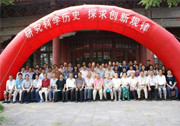| 中文题目: | 从河湖走向陂塘——宋代东南水利工程的变迁 | ||||||
| 英文题目: | From the Lakes to the Ponds——Changes of Irrigation Works in Southeast China in Song Dynasty | ||||||
| 作 者: | 谢智飞 | ||||||
| 刊物名称: | 古今农业 | ||||||
| 发表年度: | 2020 | ||||||
| 卷: | |||||||
| 期: | 2 | ||||||
| 页码: | 45-58 | ||||||
| 中文摘要: | 在农业开发从平原走向丘陵山地的背景下,宋代东南的水利工程也发生了变迁——从平原地区的河湖水利系统转向丘陵山地的陂塘水利系统。这种变化影响深远。河湖水利面临的困难有大型水利工程耗费大量的人力与资金,更有农田开发持续地侵占湖泊。相对照的是,宋代东南丘陵的陂塘水利发展迅速。陂塘是中小型的水利工程。山坡谷地流下的溪水被堰坝横截后形成陂,陂水流经沟渠灌溉农田;人们也于平地凿塘蓄水。陂塘的灌溉面积有限,但是陂塘数目增加迅速,适合东南丘陵零碎化的农田,促进了高地的农田开发。 | ||||||
| 英文摘要: | In the Song Dynasty, as the agricultural area of Southeast China was transferred from the plains to the hills and mountains, and the irrigation works were also changed –the construction sites changed from rivers to streams, and the waters to rage facilities changed from lakes to ponds. This change had a profound impact. The large-scale irrigation works based on rivers and lakes cost too many labors and funds. What’s worse, the farmland continuously occupied the lakes. In contrast, the irrigation works characterized by streams and ponds developed rapidly in Hilly Region of Southeast China. Ponds were small irrigation works. The stream flowing down the hill side or valley was blocked by a weir or a dam, forming a pond. The water in the pond flowed through the ditch to irrigate the farmland. People also dug ponds on flat ground to store water. The irrigation area of a pond was limited, but the number of ponds increased rapidly. Ponds were suitable for the fragmented farmland in Hilly Region of Southeast China, and they promoted the development of farmland in the highlands. | ||||||








